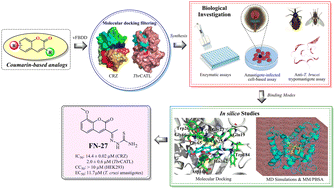Coumarin-based derivatives targeting Trypanosoma cruzi cruzain and Trypanosoma brucei cathepsin L-like proteases†
Abstract
The protozoa, Trypanosoma cruzi (etiological agent of Chagas diseases – also named American trypanosomiasis) and T. brucei (causative agent of human African trypanosomiasis – HAT), negatively impact public health, being endemic in several countries and leading to thousands of deaths per year. Moreover, the pharmacological treatment of diseases has several limitations, such as parasitic resistance and several side effects in patients, which decrease therapeutic adherence. Two cysteine proteases, cruzain (CRZ) from T. cruzi and a cathepsin L-like enzyme (TbrCATL) from T. brucei, are considered promising targets of these protozoa since they are responsible for many key biological processes in their life cycles. Coumarin analogs have been reported in diverse studies targeting the development of trypanocidal agents, and have shown activity against different evolutionary forms of these parasites. In this study, we report a virtual fragment-based drug design (vFBDD) approach to develop coumarin-based analogs capable of inhibiting these main cysteine proteases. Also, their experimental validation involved enzymatic inhibition, in vitro infected-cell-based, and antitrypomastigote assays. One compound, FN-27, a coumarin-thiosemicarbazone analog, inhibited both CRZ (IC50: 14.4 μM ± 0.02) and TbrCATL (IC50: 2.0 μM ± 0.6), and exhibited trypanocidal activity against T. cruzi amastigote-infected cells (EC50: 5.5 μM), but had no effect on T. brucei trypomastigotes. These results suggest that FN-27 probably exerts its mechanism of action against the T. cruzi parasite via inhibition of CRZ, although other targets could be involved. In parallel, FN-10, a coumarin-chalcone analog, was active against T. brucei trypomastigotes (EC50: 4.8 μM ± 0.15) but it did not inhibit CRZ or TbrCATL. Accordingly, FN-10 may exhibit its effects via a different macromolecular target(s) in each parasite. For FN-27, molecular dynamics (MD) simulations were performed to gain insights into the stability of its final complexes with both proteases within 200 ns, and the parameters RMSD, RMSF, Rg, and SASA were determined, through which it was verified that FN-27 adopts various binding modes in the catalytic site for both proteases, corroborating our experimental data. MM/PBSA calculations suggested that the most relevant stabilizing interactions for the complex formation were van der Waals interactions. Also, it was noted that the binding energy (ΔEMM) for TbrCATL is more favorable than for CRZ, again corroborating the enzymatic inhibition assays. Overall, the data generated will be useful in developing novel natural-product-based inhibitors targeting both cysteine proteases.



 Please wait while we load your content...
Please wait while we load your content...